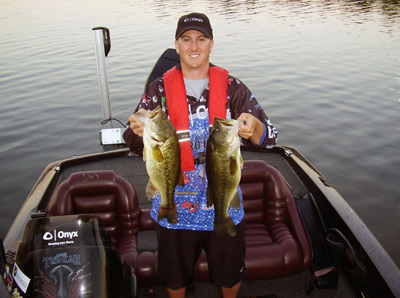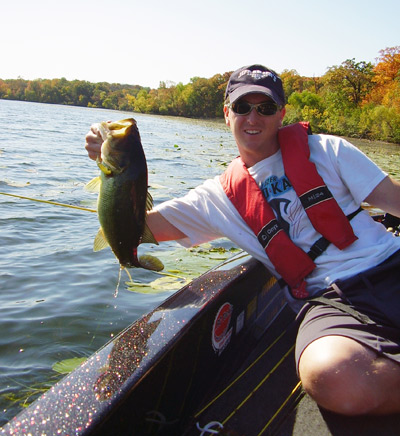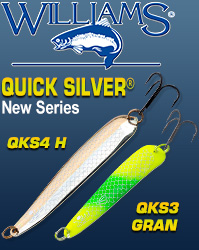Swimming Jigs 101 A look at this versatile technique
By Glenn Walker
A technique and lure that has taken the nation by storm got its start here in the Midwest on the Mississippi River. Tournament bass anglers began crafting their own swimming jigs after they realized that the jig, a proven bass-catching lure, worked well when it was swam back to the boat. Through numerous prototypes and countless hours on the water, the swim jig and the technique that accompanies it have taken hold of the Midwest bass tournament scene.
 |
| Using a shallow water anchor to control your boat position helps yield big largemouth bass. |
The anglers that were on the forefront of this new technique racked up countless tournament wins and heavy limits of bass. Tackle companies wanted to create the perfect swim jig and offer it to all anglers across the United States since this technique gained popularity all across the United States. A swim jig is not just a lure; it is a technique. And like all techniques, there are key situations in which it shines. For an angler to become successful with this technique, he or she will need to garner the knowledge of how versatile swimming a jig is and all the components that help make a successful day on the water.
The Swim Jig
What makes a jig a swim jig? The key parts of a swim jig include a bend in the hook eye that is around 30 degrees. This allows for the jig to be swum easily, and when brought through vegetation, it will not get hung up on the eye of the jig. A perfectly balanced head is crucial, because you do not want your swim jig to roll when it is being retrieved; a rolling swim jig destroys the natural-looking appeal that a swim jig has.
Numerous manufactures are now producing their versions of swim jigs, and I suggest you try them all to find your favorite. Some form of a plastic keeper on the jig is important to keep your plastic trailer securely in place during the retrieve and your presentation looking natural.
The weedguard is another essential element of the swim jig. You do not need nor want the heavy weedguards that come on a standard flipping jig, so it is important to look at the weedguard and trim it down to your desired thickness. It is important to not flair out the weedguard because it acts as a keel and if it is flared too much on one side or the other, it will make the jig roll.
As with all fishing lures, the hook is the key element that will dictate whether you will be able to get that bass into the boat. Using a sharp, light wire hook is crucial, since you’ll be making long casts and want to get a solid hook up on a bass.
 |
|
Swimming a jig through a lily pad field produced this nice largemouth bass! |
Trailers
The predominant and most popular swim jig trailer is the single tail grub. The majority of the year I use a 5-inch one on my swim jigs. It has a durable body, and the tail has the perfect thickness, so it gives off good action. Be careful that the grub you choose doesn’t have a thin tail; if it is too thin, the tail will often get hung up on the hook point.
If the fish are in a sluggish mood or are feeding on smaller baitfish, then I downsize to a 4-inch grub. This makes your lure presentation more compact and matches the hatch in a situation where the bite is tough. Regardless of what size grub you use as a trailer, it is important that you have the tail of the grub pointed away from the hook. This will increase its action and decrease the chances of it getting hung up on the jig’s hook.
The double tail grub is a solid option for a swim jig trailer when you want to add some bulk to your jig and create a larger profile for the bass to key in on when feeding. The double tail grub is my choice when I am retrieving my swim jig slow and letting it crawl along the bottom to mimic a crawfish. Since it has two tails, this trailer works better in water that has sparse to no vegetation.
Technique
The retrieve and technique of swimming a jig comes down a lot to how the bass are feeding and what they tell you on the water about how they want the bait to be retrieved. There are three basic retrieves that I employ when throwing a swim jig: a steady retrieve, a reel and twitch, and a slow roll.
When starting the day out, a simple steady retrieve is a good choice because it allows the bass to react to the bait and in turn give tell you, the angler, more details about how the bass want the bait presented. If the bass are following up your swim jig on the slow and steady retrieve but not biting, I switch over to the reel and twitch.
A slow roll retrieve is ideal when the bass are holding tight to structure that is bottom-oriented. I use this technique a lot when I am fishing rock flats with scattered vegetation in 6 to 10 feet of water. I’ll cast my jig out, let it sink down, and retrieve it in just fast enough to keep the tail of the grub moving. The slow roll retrieve is also effective when bass are feeding on crawfish. A slow-moving swim jig along the bottom does a great job mimicking a crawfish.
Colors
Selecting the color of your swim jig comes down to several things. First and foremost is water clarity. If the water clarity is good, I select a jig color that looks natural and portrays the forage that the bass are feeding on. When you go to a new body of water, it is important to determine what the bass are feeding on and to evaluate what the water clarity is like. If the water clarity is poor and the bass aren’t able to zero in on the swim jig before biting it, I select a color that is more eye-catching and stands out in the tinted water. Here is a list of my top color picks and the time of year that I use them.
- Spring: Black/Blue, Chartreuse/White; Bluegill
- Summer: White, Black/Blue, Chartreuse/White; Bluegill
- Fall: Shad patterns (White, Splatterback Shad and Sexy Shad)
Determining the correct swim jig color will take some trial and error, but that is the fun part about fishing. Tie on a jig that fits the water clarity and forage that the bass are feeding on and give it a try. My other tip on swim jig colors is, don’t be afraid to try some wild and crazy colors, because you never know what color will drive a bass wild.
When selecting the trailer color, there are two ways you can go about making your selection. First, pick a color that compliments the jig color, which creates a very natural-looking presentation. I tend to follow this idea when the bass are feeding on shad in the late summer and fall, bluegills throughout the year, and crawfish. I also pick a complimentary grub color when the water clarity is very good because the bass have a lot of time to focus in on the lure.
The second idea behind picking out a trailer color is to use one that contrasts the jig color. Early in the season I like to use trailers that grab the bass’ attention. If the water clarity is poor, I use colors like white and sapphire blue. Sometimes using a contrasting trailer color may look a little odd to you, but to the bass it may look delicious, so don’t be afraid to try something new.
A reliable way to tell if you are presenting the appropriate jig, grub color, and size to the bass is to note that if a short-striking fish pulls the grub down, you need to change the color of the grub. Since a swim jig is compact in size, the bait will almost always end up well inside the fish’s mouth if the right color and weight are being used. Until you achieve this, you can continue to tinker with your swim jig and grub combination.
Location, Location, Location!
The majority of areas and situations in which a swimming jig will shine revolve around shallow water structured-filled waters. One of my favorite and productive times to use a swim jig is following the spawn when the bass are guarding their fry. A swim jig does a great job imitating something trying to disrupt those fry, and bass will destroy your jig. A similar situation when the swim jig is a smart lure choice is during the time when the bluegill and other panfish spawn. Bass will stalk the shallows, looking for an easy meal, and a swim jig brought through the panfish spawning areas will pay off.
Ambush points are obvious in many areas. Whether they funnel down in weeds, channel openings, current breaks, docks, lay downs, or bottom composition changes, they all are great areas to catch bass. Fishing these areas is where swimming jigs shine, because you can present your lure effectively through the cover and you can cover a vast amount of water in a short amount of time.
One of my favorite ways to fish a swim jig on the Mississippi River is to through it on top of the weed mats, which, depending on the time of year, can include lily pads, floating cut weeds, and grass. The key to fishing weed mats with a swim jig is to get the bait coming across the mat to the edge and then dropping it. Anything that was watching it come across the mat will track it to the edge and strike as your jig falls into the open water.
This past tournament season I fished a circuit that traveled to some of the premier bass lakes of Minnesota, so I was forced to adapt my strengths of shallow water fishing to the deep water I would be fishing. I was still able to fish my swim jig in shallow water around boat docks and inside weedlines, which helped me put together limits of bass in several of the tournaments. The feat that I was very proud of was that I was able to adapt my swim jig technique to water that was 5 to 12 feet deep.
Switching from my standard ¼ oz. jig and going to the 3/8 oz. size allowed me to get my lure deeper in the water column where the bass were holding tight to the bottom. Whether they were keying in on a rock flat or on the edge of a deep weedline, the swim jig worked!
Making long casts, allowing my jig to sink down to the target depth and keeping a slow, steady retrieve was instrumental in helping me maintain my swim jig in the strike zone. The two areas where I found the deep swim jig bite to be successful were flats and weedlines. The flats could be a rock or weed flat, but just retrieving the swim jig back and letting it tick the tops of the weeds or bump into the rocks worked very well.
When I used the swim jig to fish deep weedlines, I would cast the jig out just beyond the edge of the weedline. I would quickly engage my reel and bring the swim jig back in so it would tick the top of the weeds. When my jig got to the edge, I let if fall down the face of the weedline. If I was able to make a cast parallel to the weedline, I would let the jig sink down to the edge of the weeds and steadily bring it back to make sure it stayed in the strike zone.
Now that you are well-informed about the swimming jig technique, I encourage you to give it a try.
Be sure to check out www.fishglenn.com to learn more about Glenn Walker and see a video on the swimming jig.









